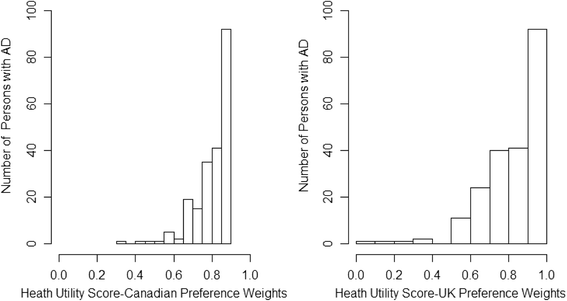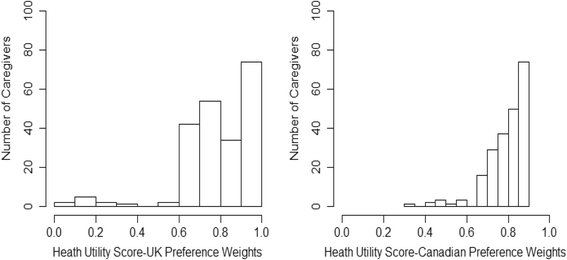A comparison of health utility scores calculated using United Kingdom and Canadian preference weights in persons with alzheimer's disease and their caregivers
- PMID: 27431327
- PMCID: PMC4950771
- DOI: 10.1186/s12955-016-0510-y
A comparison of health utility scores calculated using United Kingdom and Canadian preference weights in persons with alzheimer's disease and their caregivers
Abstract
Background: The use of the EQ-5D to asses the economic benefits of health technologies has led to questions about the cross-population transferability of preference weights to calculate health utility scores. The aim of this study is to investigate whether the use of UK and Canadian preference weights will lead to the calculation of different health utility scores in a sample of persons with Alzheimer's disease (AD) and their primary informal caregivers.
Methods: We recruited 216 patient-caregiver dyads from nine geriatric and memory clinics across Canada. Participants used the EQ-5D-3L to rate their health-related quality-of-life (HRQoL). EQ-5D-3L responses were transformed into health utility scores using UK and Canadian preference weights. The levels of agreement between the two sets of scores were assessed using intraclass correlation coefficients (ICCs). Bland-Altman plots depicted individual-level differences between the two sets of scores. Differences in health utility scores were tested using the Wilcoxon signed rank sum test. A generalized linear model with a gamma distribution was used to examine whether participants' socio-demographic characteristics were associated with their health utility scores.
Results: The distributions of health utility scores derived from both the UK and Canadian preference weights were skewed to the left. The intraclass correlation coefficient was 0.94 (95 % CI: 0.92, 0.95) for persons with AD and 0.92 (95 % CI: 0.88, 0.94) for the caregivers. The Canadian weights yielded slightly higher median health utility scores than the UK weights for caregivers (median difference: 0.009; 95 % confidence interval: 0.007, 0.013). This finding persisted after stratifying by disease severity. Few socio-demographic characteristics were associated with the two sets of health utility scores.
Conclusions: Health utility scores exhibited small and clinically unimportant differences when calculated with UK versus Canadian preference weights in persons with AD and their caregivers. The original UK and Canadian population samples used to obtain the preference weights valued health states similarly.
Keywords: Alzheimer’s disease; Caregiver; EQ-5D-3L; Health-related quality-of-life.
Figures
Similar articles
-
Spillover Effects on Caregivers' and Family Members' Utility: A Systematic Review of the Literature.Pharmacoeconomics. 2019 Apr;37(4):475-499. doi: 10.1007/s40273-019-00768-7. Pharmacoeconomics. 2019. PMID: 30887469
-
Health utility scores in Alzheimer's disease: differences based on calculation with American and Canadian preference weights.Value Health. 2014 Jan-Feb;17(1):77-83. doi: 10.1016/j.jval.2013.10.009. Value Health. 2014. PMID: 24438720
-
Can the general public use vignettes to discriminate between Alzheimer's disease health states?BMC Geriatr. 2016 Feb 3;16:36. doi: 10.1186/s12877-016-0207-4. BMC Geriatr. 2016. PMID: 26842500 Free PMC article.
-
A comparison of EQ-5D index scores using the UK, US, and Japan preference weights in a Thai sample with type 2 diabetes.Health Qual Life Outcomes. 2008 Sep 23;6:71. doi: 10.1186/1477-7525-6-71. Health Qual Life Outcomes. 2008. PMID: 18811935 Free PMC article.
-
Utility scores for different health states related to depression: individual participant data analysis.Qual Life Res. 2017 Jul;26(7):1649-1658. doi: 10.1007/s11136-017-1536-2. Epub 2017 Mar 4. Qual Life Res. 2017. PMID: 28260149 Free PMC article. Review.
Cited by
-
Eliciting national and subnational sets of disability weights in mainland China: Findings from the Chinese disability weight measurement study.Lancet Reg Health West Pac. 2022 Jul 26;26:100520. doi: 10.1016/j.lanwpc.2022.100520. eCollection 2022 Sep. Lancet Reg Health West Pac. 2022. PMID: 35910433 Free PMC article.
-
Spillover Effects on Caregivers' and Family Members' Utility: A Systematic Review of the Literature.Pharmacoeconomics. 2019 Apr;37(4):475-499. doi: 10.1007/s40273-019-00768-7. Pharmacoeconomics. 2019. PMID: 30887469
-
Age- and sex-specific Canadian utility norms, based on the 2013-2014 Canadian Community Health Survey.CMAJ. 2018 Feb 12;190(6):E155-E161. doi: 10.1503/cmaj.170317. CMAJ. 2018. PMID: 29440335 Free PMC article.
-
The effectiveness and cost-effectiveness of assistive technology and telecare for independent living in dementia: a randomised controlled trial.Age Ageing. 2021 May 5;50(3):882-890. doi: 10.1093/ageing/afaa284. Age Ageing. 2021. PMID: 33492349 Free PMC article. Clinical Trial.
-
Quality of Life in Caregivers of Patients Randomized to Standard- Versus Extended-Hours Hemodialysis.Kidney Int Rep. 2021 Feb 1;6(4):1058-1065. doi: 10.1016/j.ekir.2021.01.020. eCollection 2021 Apr. Kidney Int Rep. 2021. PMID: 33912756 Free PMC article.
References
-
- Kalaria RN, Maestre GE, Arizaga R, Friedland RP, Galasko D, Hall K, Luchsinger JA, Ogunniyi A, Perry EK, Potocnik F. Alzheimer’s disease and vascular dementia in developing countries: prevalence, management, and risk factors. Lancet Neurol. 2008;7:812–26. doi: 10.1016/S1474-4422(08)70169-8. - DOI - PMC - PubMed
-
- Bowling A.Health-related quality of life: a discussion of the concept, its use and measurement. In Measuring disease: a review of disease-specific quality of life measurement scales. 2nd edition. Buckingham: Open University Press; 1995. p. 1-19.
Publication types
MeSH terms
LinkOut - more resources
Full Text Sources
Other Literature Sources
Medical




